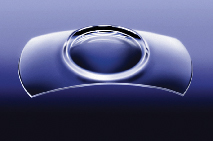Researchers in Oregon set out to evaluate the clinical outcomes of the new phacoemulsification technologies: NeoSoniX on the Legacy (Alcon Surgical), phaco burst mode on the Millennium (Bausch & Lomb), sonic phaco on the Staar Wave (Staar Surgical), and WhiteStar on the Sovereign (Advanced Medical Optics). They noted improvements in effective phaco time (EPT), average phaco power, percentage of clear corneas and 20/40 or better UCVA at the first postop visit for most systems using the new technology. These translate to improved clinical outcomes, say the researchers.
| Clinical Outcomes of Phaco Advancements | |||||||
| Technology | No. of Eyes | Mean Patient Age (years) | Mean Grade of Nucleus | EPT (s) | Average Phaco Power (%) | Clear Corneas at 1st Postop Visit (%) | 20/40 or better UVCA at 1st Postop Visit (%) |
| Legacy | 11.51 | 15 | 90 | 70 | |||
| NeoSoniX | 46 | 71.9 | 1.9 | 1.50 | 6.5 | 98 | 96 |
| Millennium | 5.44 | 13 | 91 | 91 | |||
| Phaco Burst | 18 | 70.4 | 1.4 | 3.10 | 8.8 | 100 | 100 |
| Wave | 2.85 | 7.2 | 95 | 79 | |||
| Sonic Wave | 43 | 76 | 1.9 | 3.95 | 7.6 | 95 | 74 |
| Sovereign | 2.65 | 2 | 88 | 81 | |||
| WhiteStar | 18 | 69.2 | 1.9 | 1.55 | 1.8 | 100 | 94 |
| EPT = effective phaco time. *New technology appears under older technology in column 1. | |||||||
One surgeon performed all of the procedures. After determining the best possible settings and performance on each system, a series of consecutive cases was randomly assigned to surgery with one of the four systems. Investigators compared outcomes with previously published results on the same machines before the addition of the new technology (See Table).
For NeoSoniX, phaco burst and WhiteStar, new technology led to a reduction in EPT and improvement in the percentage of clear corneas and patients having a UCVA of 20/40 or better at the first postop visit. The percentages didn't change from the Wave to the SonicWave, but researchers attribute this to good outcomes on that machine before the introduction of sonics.
(J Cataract Refract Surg 2004;30:1014-1019)
Fine IH, Packer M, Hoffman R
Deposits after PK from Gatifloxacin
Researchers in Dallas and Nashville have determined that gatifloxacin, a 4th-generation fluoroquinolone, like ciprofloxacin, a 2nd-generation fluoroquinolone, can cause intrastromal macroscopic crystalline deposits through a compromised corneal epithelium.
The researchers describe a case of intrastromal corneal crystalline deposits in an 85-year-old male patient three weeks after penetrating keratoplasty and postop treatment with topical 0.3% gatifloxacin, in the presence of a transient epithelial defect.
The patient's history included bilateral cataract extraction without lens implantation, development of bilateral open-angle glaucoma followed by aphakic bullous keratopathy, penetrating keratoplasty (OD) with IOL implantation, and PK (OS) with intraocular and Ahmed valve implantation. Three years later, the patient returned with a clear graft (OD) but a failed opacified graft OS. For this eye, the patient again underwent PK. The donor cornea button showed healthy endothelium and a clear stroma. Left-eye surgery was uneventful.
From the first day postop, the patient was treated with 1% prednisolone acetate ophthalmic suspension and 0.3% gatifloxacin eyedrops in the left eye. Three weeks later, the research team found numerous large, diffuse precipitates. Gatifloxacin was discontinued and substituted with a neomycin-polymixin B-dexamethasone ophthalmic ointment.
At six months postop, the corneal deposits remained unchanged. BCVA in the left eye was 20/80. Intraocular pressure was 20 mmHg in the righteye and 14 mmHg in the left eye.
Researchers note that in this patient, the exclusive confinement of the crystals to the donor graft while sparing the recipient side, together with the normal laboratory results and the nonsuggestive medical history, weigh strongly against a systemic cause. They urge caution in the use of 0.3% gatifloxacin after PK, and suggest that a fluoroquinolone with a less acidic pH may be a better choice.
(Eye & Contact Lens 2004;30 (3):169-172)
Awwad S, Haddad W, Wang M, Parmar D, Conger D, Cavanagh HD
PRL Results Promising
Results of the treatment of high myopia with the phakic refractive lens (PRL, CIBA Vision Surgical) are encouraging, say investigators in Crete. They implanted a silicone PRL in the posterior chamber of 34 myopic eyes of 19 patients. The mean patient age was 29 ± 7.9 years. Mean preop spherical equivalent was -14.70 ± 2.65 D; mean preop refractive cylinder was -2.02 D.
 |
There was no statistically significant difference in higher-order aberrations after PRL implantation (P = .12)
(J Cataract Refract Surg 2004; 30:1190-1197)
Pallikaris I, Kalyvianaki M, Kymionis G, Panagopoulou S



